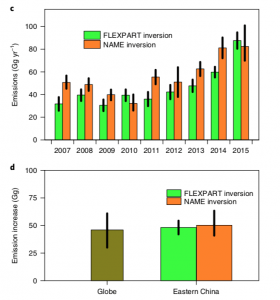We have now published a series of studies showing the release of ozone-depleting substances from East Asia. The substances we have studied are CFC-11, chloroform (CHCl3) and carbon tetrachloride (CCl4). Production of all of these. are banned under the Montreal Protocol.
A study using measurements from NOAA “background” stations showed an increase in global CFC-11 emissions. Our subsequent study (Rigby et al., Nature, 2019) pinpointed this increase to have originated from eastern mainland China, likely from illegal new production. The goal of our work is to find these emissions sources so that they can be shut down. We hope to show that they are no longer continuing.


Our study using measurements from Gosan, Korean and Hateruma, Japan, that emissions of chloroform from eastern China began increasing after 2010. We showed that the increase from eastern China can explain the majority of the total global increase. Chloroform has both anthropogenic and natural emissions and because of its short lifetime, is not regulated under the Montreal Protocol. However, in certain regions of the world such as Asia, the monsoon provides an efficient transport pathway of these “Very Short Lived Substances” to the ozone layer. Thus, they have a significant impact on the recovery of the ozone layer. We show that the emissions from eastern China could delay ozone layer recovery by a few years.
Finally, our study on carbon tetrachloride, also using measurements from Gosan, Korea, showed that emissions from China did not decrease, despite inventories suggesting the contrary. Global emissions estimates show that there is a large number of emissions not accounted for by global inventories. We show that much of these “unaccounted for” emissions originate from eastern China.